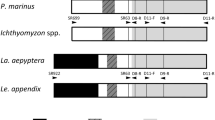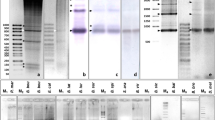Summary
The early ontogenetic segregation of germ line and somatic cells in the animal kingdom is phylogenetically very old and represents probably the first step in differentiation. While this phenomenon has been shown to occur in various animal phyla, it seems to be completely msssing in the plant kingdom. In several animal species, the segregation of the germ and somatic cell lines is accompanied by the loss of whole or parts of chromosomes in the presumptive somatic cells. The cause of the chromatin diminution process as well as the significance of the germ line limited DNA sequences in species undergoing chromatin or chromosome loss still remain unknown. However, using modern biochemical and molecular biological techniques, it has become possible to analyze the process of chromatin diminution and the composition of the germ line specific DNA sequences at the molecular level.
InAscaris lumbricoides, about a quarter of the total amount of germ line DNA is eliminated from the presumptive somatic cells during chromatin diminution. Hybridization experiments revealed that germ line and somatic DNA contain the same percentage of 18S+28S rRNA genes. Therefore, chromatin diminution does not serve to discard large amounts of rRNA-coding genes from the germ line cells. On the other hand, over 99%, but not all satellite DNA sequences present in the germ line genome, are expelled from the presumptive somatic cells by chromatin diminution. Molecular cloning and sequence analysis of different restriction endonuclease fragments isolated from the germ line satellite DNA indicated that this eliminated satellite is composed of a whole set of related variant sequences, which differ by small deletions, insertions and single base substitutions. Members of the same variant class are tandemly linked and therefore physically separated from other variant classes. By comparing all the determined sequences, it was possible to establish a 121 bp long and AT rich consensus sequence which itself exhibits an 11 bp long internal short range periodicity. We have no indication for transcriptional activity of the satellite DNA sequences at any stage or tissue tested. Evidence is accumulating that the eliminated DNA contains also other DNA sequences apart from the class of highly repetitive satellite DNA.
Similar content being viewed by others
References
Albertson, D.G., Nwaorgu, O.C., and Sulston, J.E., Chromatin diminution and a chromosomal mechanism of sexual differentiation inStrongyloides papillosus. Chromosoma75 (1979) 75–87.
Ammermann, D., Chromatin diminution and chromosome elimination: Mechanisms and adaptive significance, in: DNA and evolution: Natural selection and genome size. Ed. T. Cavalier-Smith. John Wiley and Sons, New York 1985 (in press).
Back, E., Müller, F., and Tobler, H., Structural organization of the two main rDNA size classes ofAscaris lumbricoides. Nucl. Acids Res.12 (1984) 1313–1332.
Back, E., Felder, H., Müller, F., and Tobler, H., Chromosomal arrangement of the two main rDNA size classes ofAscaris lumbricoides. Nucl. Acids Res.12 (1984) 1333–1347.
Bantock, C.R., Experiments on chromosome elimination in the gall midge,Mayetiola destructor. J. Embryol. exp. Morph.24 (1970) 257–286.
Beams, H.W., and Kessel, R.G., The problem of germ cell determinants, in: Int. Rev. Cytol. pp. 418–479. Eds G. H. Bourne, J. F. Danielli and K. W. Jeon. Academic Press, New York 1974.
Bonnevie, K., Über Chromatindiminution bei Nematoden. Jena. Z. Naturw.36 (1902) 275–288.
Boveri, T., Über Differenzierung der Zellkerne während der Furchung des Eies vonAscaris megalocephala. Anat. Anz.2 (1887) 688–693.
Boveri, T., Über die Entstehung des Gegensatzes zwischen den Geschlechtszellen und den somatischen Zellen beiAscaris megalocephala. Sber. ges. Morph. Physiol. Münch.8 (1892) 114–125.
Boveri, T., Die Entwicklung vonAscaris megalocephala mit besonderer Rücksicht auf die Kernverhältnisse. Festschr. C. von Kupffer (Jena) (1899) 383–430.
Boveri, T., Die Potenzen der Ascaris-Blastomeren bei abgeänderter Furchung. Zugleich ein Beitrag zur Frage qualitativ-ungleicher Chromosomen-Teilung. Festschr. R. Hertwig (Jena)3 (1910) 131–214.
Britten, R. J., and Kohne, D. E., Nucleotide sequence repetition in DNA. Yb. Carnegie Instn Wash.65 (1966) 78–106.
Davis, A. H., Kidd, G. H., and Carter, C. E., Chromosome diminution inAscaris suum. Two-fold increase of nucleosomal histone to DNA ratios during development. Biochim. biophys. Acta565 (1979) 315–325.
Eddy, E.M., Germ plasm and the differentiation of the germ cell line, in: Int. Rev. Cytol., pp. 229–280. Eds G. H. Bourne, J. F. Danielli and K. W. Jeon. Academic Press, New York 1975.
Edwards, C. L., The idiochromosomes inAscaris megalocephala andAscaris lumbricoides. Arch. Zellforsch.5 (1910) 422–429.
Emmons, S. W., Klass, M. R., and Hirsh, D., Analysis of the constancy of DNA sequences during development and evolution of the nematodeCaenorhabditis elegans. Proc. natn. Acad. Sci. USA76 (1979) 1333–1337.
Felder, H., Lokalisierung von hochrepetitiven DNA-Sequenzen und ribosomalen Genen auf Chromosomen vonAscaris lumbricoides var.suum mittels In-situ-Hybridisierungsexperimenten, pp. 1–54. Diploma thesis, University of Freiburg, Switzerland, 1983.
Gerhart, J. C., Mechanisms regulating pattern formation in the amphibian egg and early embryo, in: Biological regulation and development, vol. 2, pp. 133–316. Ed. R. F. Goldberger. Plenum Press, New York 1980.
Goldstein, P., and Straus, N.A., Molecular characterization ofAscaris suum DNA and of chromatin diminution. Exp. Cell Res.116 (1978) 462–466.
Goodrich, H. B., The germ cells inAscaris incurva. J. exp. Zool.21 (1916) 61–99.
Goswami, U., Chromatin elimination in a rare species of nematodePhysaloptera indiana. Curr. Sci.42 (1973) 576–577.
Illmensee, K., and Mahowald, A. P., Transplantation of posterior polar plasm inDrosophila. Induction of germ cells at the anterior pole of the egg. Proc. natn. Acad. Sci. USA71 (1974) 1016–1020.
Illmensee, K., and Mahowald, A. P., The autonomous function of germ plasm in a somatic region of theDrosophila egg. Exp. Cell Res.97 (1976) 127–140.
Kaulenas, M. S., and Fairbairn, D., RNA metabolism of fertilizedAscaris lumbricoides eggs during uterine development. Exp. Cell Res.52 (1968) 233–251.
mahowald, A. P., and Boswell, R. E., Germ plasm and germ cell development in invertebrates, in: Current Problems in Germ Cell Differentiation, pp. 3–17. Eds A. McLaren and C. C. Wylie. Cambridge University Press, Cambridge 1983.
Meyer, O., Celluläre Untersuchungen an Nematoden-Eiern. Jena. Z. Naturw.29 (1895) 391–410.
Moritz, K. B., DNS-Variation im keimbahnbegrenzten Chromatin und autoradiographische Befunde zu seiner Funktion beiParascaris equorum. Verh. dt. zool. Ges.64 (1970) 36–42.
Moritz, K. B., and Roth, G. E., Complexity of germ line and somatic DNA inAscaris. Nature259 (1976) 55–57.
Mutafova, T., Morphology and behaviour of sex chromosomes during meiosis inAscaris suum. Z. Parasitenkde46 (1975) 291–295.
Müller, F., Walker, P., Aeby, P., Neuhaus, H., Back, E., and Tobler, H., Molecular cloning and sequence analysis of highly repetitive DNA sequences contained in the eliminated genome ofAscaris lumbricoides, in: Embryonic development, Part A.: Genetic aspects, pp. 127–138. Eds M. M. Burger and R. Weber. Alan R. Liss, New York 1982.
Müller, F., Walker, P., Aeby, P., Neuhaus, H., Felder, H., Back, E., and Tobler, H., Nucleotide sequence of satellite DNA contained in the eliminated genome ofAscaris lumbricoides. Nucl. Acids Res.10 (1982) 7493–7510.
Nelson-Rees, W.A., Hoy, M.A., and Roush, R.T., Heterochromatinization, chromatin elimination and haploidization in the parahaploid miteMetaseiulus occidentalis (Nesbitt) (Acarina: Phytoseiidae). Chromosoma77 (1980) 263–276.
Nieuwkoop, P. D., and Sutasurya, L. A., Primordial germ cells in the invertebrates, pp. 1–258. Cambridge University Press, Cambridge 1981.
Painter, T.S., Chromatin diminution. Trans. Conn. Acad. Arts Sci.36 (1945) 443–448.
Pasternak, J., and Barrell, R., Quantitation of nuclear DNA inAscaris lumbricoides: DNA constancy and chromatin diminution. Genet. Res. Cambridge27 (1976) 339–348.
Roth, G. E., Satellite DNA properties of the germ line limited DNA and the organization of the somatic genomes in the nematodesAscaris suum andParascaris equorum. Chromosoma74 (1979) 355–371.
Roth, G. E., and Moritz, K. B., Restriction enzyme analysis of the germ line limited DNA ofAscaris suum. Chromosoma83 (1981) 169–190.
Sonnenblick, B. P., The early embryology ofDrosophila melanogaster, in: Biology of Drosophila, pp. 62–163. Ed. M. Demerec. Hafner Publ. Comp., New York 1965.
Streeck, R. E., Moritz, K. B., and Beer, K., Chromatin diminution inAscaris suum: nucleotide sequence of the eliminated satellite DNA. Nucl. Acids Res.10 (1982) 3495–3502.
Sulston, J. E., and Brenner, S., The DNA ofCaenorhabditis elegans. Genetics77 (1974) 95–104.
Tobler, H., Smith, K. D., and Ursprung, H., Molecular aspects of chromatin elimination inAscaris lumbricoides. Devl Biol.27 (1972) 190–203.
Tobler, H., and Gut, C., Mitochondrial DNA from 4-cell stages ofAscaris lumbricoides. J. Cell Sci.16 (1974) 593–601.
Tobler, H., Zulauf, E., and Kuhn, O., Ribosomal RNA genes in germ line and somatic cells ofAscaris lumbricoides. Devl Biol.41 (1974) 218–223.
Tobler, H., Genetic difference between germ line and somatic DNA inAscaris lumbricoides, in: Progress in differentiation research, pp. 147–154. Eds N. Müller-Bérat, C. Rosenfeld, D. Tarin and D. Viza. North-Holland Publ. Comp., Amsterdam 1976.
Tobler, H., The differentiation of germ and somatic cell lines in nematodes, in: Germ-Line Soma Differentiation, Results and Problems in Cell Differentiation. Ed. W. Hennig. Springer-Verlag, Berlin 1985 (in press).
Wallace, H., Morray, J., and Langridge, W. H. R., Alternative model for gene amplification. Nature New Biol.230 (1971) 201–203.
Walton, A. C., The oogenesis and early embryology ofAscaris canis Werner. J. Morph.30 (1917) 527–603.
Walton, A. C., Studies on nematode gametogenesis. Z. Zell.-Gewebelehre1 (1924) 167–239.
Weismann, A., Die Continuität des Keimplasmas als Grundlage einer Theorie der Vererbung. Fischer, Jena 1885.
Whitington, P. M., and Dixon, K. E., Quantitative studies of germ plasma and germ cells during early embryogenesis ofXenopus laevis. J. Embryol. exp. Morph.33 (1975) 57–74.
Yao, T., and Pai, S., Heteropycnosis and chromatin diminution inCosmocerca sp.. Sci. Rec. Acad. sin.1 (1942) 197–202.
Author information
Authors and Affiliations
Rights and permissions
About this article
Cite this article
Tobler, H., Müller, F., Back, E. et al. Germ line — soma differentiation inAscaris: A molecular approach. Experientia 41, 1311–1319 (1985). https://doi.org/10.1007/BF01952073
Issue Date:
DOI: https://doi.org/10.1007/BF01952073




